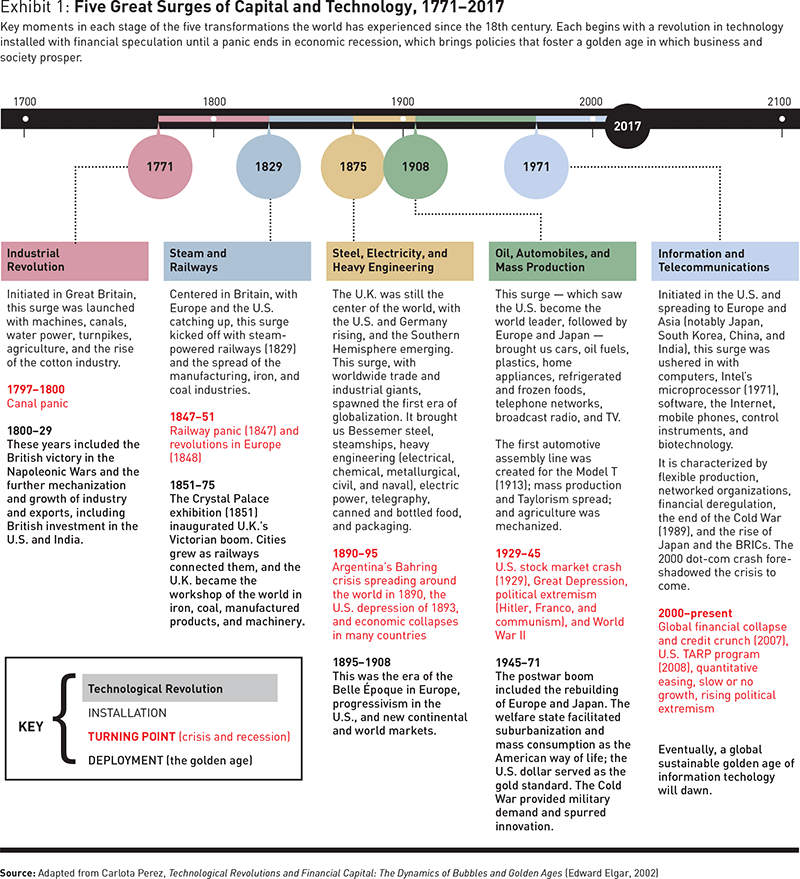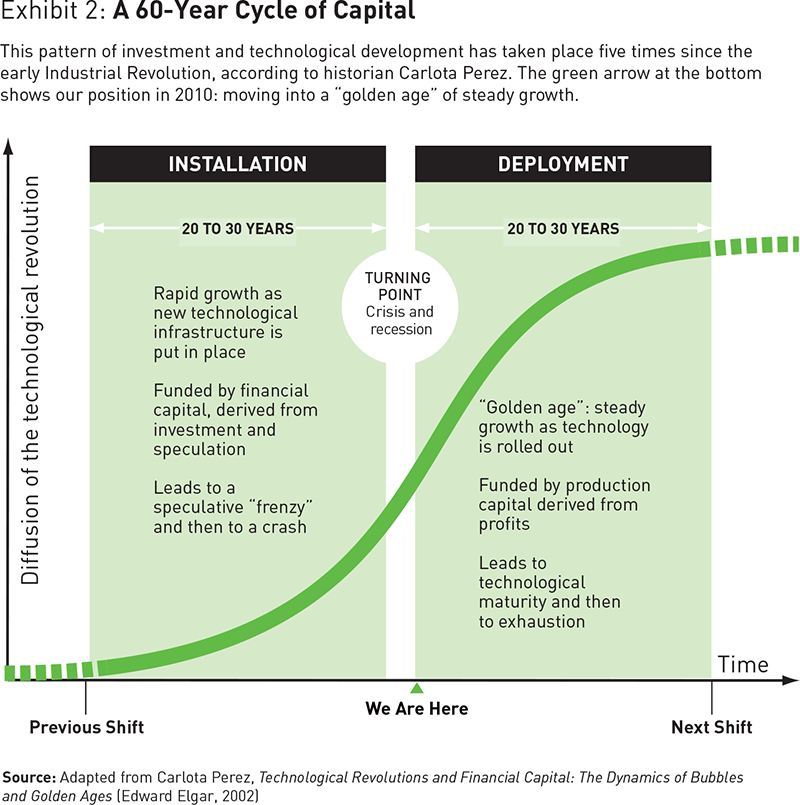A long-wave theory of technological and economic change suggests the financial malaise that began in 2007 may be about to end.
History doesn’t exactly repeat itself, but it does run in cycles. One of the most robust theories of such cycles was articulated by economic historian Carlota Perez, in her influential book Technological Revolutions and Financial Capital: The Dynamics of Bubbles and Golden Ages (Edward Elgar, 2002). It suggests that humanity can get through the current period of upheaval and economic malaise and enter a new “golden age” of broad economic growth, if the world’s key decision makers act in concert to help foster one.
This may seem far-fetched, but it’s happened four times before. We are in the midst of the fifth great surge (as Perez calls them) of technological and economic change since the Industrial Revolution. The last one, the age of oil, automobiles, and mass production, lasted most of the 20th century and still shapes many people’s attitudes. Our current surge started around 1970 and has rolled out information and communications technology around the world: It is the age of the computer and the Internet (see Exhibit 1).

Each of these surges follows the same broad pattern. First, there is a wave of major new technologies, leading to dramatic changes in industrial production and daily life. For about 20 to 30 years, in a period that Perez calls installation, these technologies are funded largely by speculative investment chasing rapid returns. This age of widening wealth disparity leads to a bubble, which bursts in spectacular fashion, and is followed by a crisis period that Perez calls the turning point. This phase of economic and social turbulence has varied in length from two years to 17. Many efforts to get back to normal are made, usually involving the regulation of financial excesses or the stimulation of production and employment. When the crisis ends, the third part of the cycle begins; it consists of 30 years or so of stable economic growth, with a high level of genuine return on investment, and an economy funded by production capital, not speculation. Perez calls this period deployment. It is experienced as a golden age: a wave of prosperity, lifting everyone’s fortunes, including those who felt left behind just a few years before. Eventually, the technological opportunities reach exhaustion, markets become saturated, and the cycle starts all over again (see Exhibit 2).

Of course, these are broad observations, and nothing guarantees that the pattern will continue. But its overall logic is compelling. To Perez, the dramatically powerful technologies of Wall Street, Silicon Valley, and Industry 4.0 have provoked, in effect, a worldwide economic revolution, starting in the 1970s, challenging the equally powerful technologies of the fourth surge: oil, automobiles, and mass production. To turn the corner from crisis to golden age would require a major economic and political consensus: an intelligent global policy framework giving a convergent direction to investment and innovation, ensuring the growth of profitability and jobs around the world, including most major national economies. Not an easy task!
The participants in this roundtable were three longtime observers of the Perez hypothesis — including Carlota Perez. We met recently to consider this question: Given today’s political turbulence, after at least 10 years of being in the crisis phase, what would have to happen for a new golden age to begin?
—Art KleinerCauses of the Current Crisis
KLEINER: Carlota, according to your theory, we’re now about 45 years into a surge that began in the early 1970s. That’s the longest such cycle we’ve seen — and the longest period of crisis.
PEREZ: It’s probably also the deepest transformation of everyday life, and the one that has gone the furthest globally. Also, given our longer life span, the older generation has taken longer to hand over power — in this case, to younger digital natives. Even after 40 years, the information and communications technology (ICT) revolution is far from complete. It hasn’t fully changed our way of life, as previous technological revolutions had done. And it has brought a dangerous political shift, the separation of the interests of major global corporations from interests of the national societies where they are based.
During the golden age of mass production, in the 1950s and early 1960s, the interests of business and society converged. With the welfare state and suburbanization, working-class people in many Western countries could become homeowners and consumers. Therefore, when companies paid high salaries and high taxes, it all contributed to increasing domestic demand. Government support for education and health services freed up discretionary cash for people to spend on consumer products. High demand for these products created conditions for growth and profit. It was a robust positive-sum game, a super win-win between business and the majority of the population, resulting in good profits and decent livelihoods.
Then, in the 1970s, the mass production revolution hit a maturity ceiling. New products were less viable; productivity fell; markets were saturated. The welfare state became unsustainable, and national solidarity broke down. Since then, many businesses have seen their cost advantage and their customer demand migrate abroad, away from their home countries. Low salaries no longer harm business as in the past, so living standards have been declining for decades. This, together with unemployment from offshoring, goes far in explaining the Brexit referendum and the fervor of the U.S. elections in 2016.
JOHNSON: A factor that may intensify those tensions is the nature of today’s technology. We have an amazing arsenal of innovations on the threshold of realization: synthetic biology, quantum computing, blockchain, drones, autonomous vehicles, and private-citizen space travel. Potential breakthroughs are dangled before us....MUCH MORE